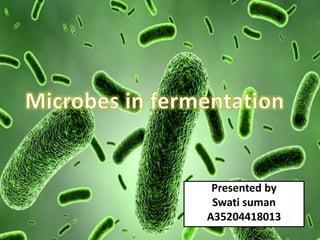
Micro flora
- 2. What is fermentation? • Fermentation in food processing is the process of converting carbohydrates to alcohol or organic acids using microorganisms—yeasts or bacteria under anaerobic conditions. Fermentation usually implies that the action of microorganisms is desired. The science of fermentation is known as zymology or zymurgy. • The term fermentation sometimes refers specifically to the chemical conversion of sugars into ethanol, producing alcoholic drinks such as wine, beer, and cider. However, similar processes take place in the leavening of bread , and in the preservation of sour foods with the production of lactic acid, such as in sauerkraut and yogurt.
- 3. Microbes in fermentation • Microorganisms determine the characteristics of fermented food, for example, acidity, flavour and texture, as well as the health benefits that go beyond simple nutrition. • Microorganisms may be present as the indigenous micro-biota of the food or as a result of the intentional addition of microorganisms as starter cultures in industrial food fermentation process.
- 4. • Also, microbial cultures can be used to produce several compounds either specifically for application as food additives or in situ as a part of food fermentation . • With an estimated 5000 varieties of fermented foods and beverages, worldwide, only a small fraction of these artisanal products have been subjected to scientific studies so far.
- 5. Types of microbes • Main types of microorganisms associated with global fermented foods and beverages are grouped as follows;- a) Bacteria b) Fungi c) yeast
- 6. Bacteria • Bacteria are the most dominant microorganisms in both naturally fermented foods and foods fermented by the use of starter cultures. Among the bacteria, lactic acid bacteria are commonly associated with acidic fermented foods, while non-LAB bacteria are also involved in food fermentation, frequently as minor or secondary groups.
- 7. • Types of bacteria in fermentation technology:- • (a) lactic acid bacteria • (b) non lactic acid bacteria • Lactic Acid bacteria :- Lactic acid bacteria are Gram-positive, catalase-negative bacteria that produce large amounts of lactic acid. The bacterial groups that make up the LAB are among the most familiar to humans, because of their association with the human environment, and with a wide range of naturally fermented dairy products, grain crops, vegetables, and so on.
- 8. • Non lactic acid bacteria - Bacillus is reported from the alkaline-fermented foods of Asia and Africa. Species of Bacillus present in fermented foods mostly soybean- based foods are B. amyloliquefaciens, B. circulans, B. coagulans, etc , while strains of B. cereus have been isolated from the fermentation of Prosopis africana seeds for the production of okpehe in Nigeria. • Some strains of B. subtilis produce λ-polyglutamic acid (PGA) which is an amino acid polymer commonly present in Asian fermented soybean foods giving the characteristic sticky texture to the product .
- 9. YEAST • The role of yeasts in food fermentation is to ferment sugar, produce secondary metabolites, inhibit growth of mycotoxin- producing molds and display several enzymatic activities such as lipolytic, proteolytic, pectinolytic, glycosidasic and urease activities .Genera of yeasts reported from fermented foods, alcoholic beverages and nonfood mixed amylolytic starters are Candida, Cryptococcus etc.
- 10. Fungi • The major roles of fungi, mostly filamentous molds, in fermented foods and alcoholic beverages are the production of intra- and extracellular proteolytic and lipolytic enzymes that highly influence the flavor and texture of the product, and also the degradation of antinutritive factors improving bioavailability of minerals. • Species of Actinomucor, Amylomyces, Aspergillus, Monascus, Mucor, Neurospora, Penicillium, Rhizopus, and Ustilago are reported from many fermented foods, Asian nonfood amylolytic starters and alcoholic beverages
- 11. Pathogenic Contaminants • About 80% of fermented foods are produced by natural fermentation and may contain functional, nonfunctional, and pathogenic microorganisms during initial fermentation. Pathogenic bacteria commonly reported for fermented foods are Escherichia coli, Listeria monocytogenes, and so on
- 12. Gut Micro flora • The human gastrointestinal tract (GIT) houses over 1014 microbial cells with over 1000 diverse bacterial types, mostly in the colon. Colonization of the gut is initiated before birth following ingestion of microbe- containing amniotic fluid by the fetus. The majority of bacteria in the adult gut are nonsporing anaerobes, the most numerically predominant of which include species of Bacteroides, Bifidobacterium, Eubacterium, Clostridium, Lactobacillus, Fusobacterium, and various Gram-positive cocci and bacteria that are present in lower numbers include Enterococcus.